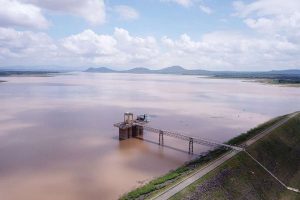 Mwea National Reserve covers an area of approximately 42 square km northwest of Kamburu Dam at the confluence of Tana and Thiba rivers. Two islands within Kamburu dam (constructed in 1976) are part of the protected area. Mwea National Reserve is located within Makima Location, Karaba Division of Mbeere District, in Eastern Province.
Mwea National Reserve covers an area of approximately 42 square km northwest of Kamburu Dam at the confluence of Tana and Thiba rivers. Two islands within Kamburu dam (constructed in 1976) are part of the protected area. Mwea National Reserve is located within Makima Location, Karaba Division of Mbeere District, in Eastern Province.
Southern boundary of the reserve is bound by Tana river while East boundary conforms to Thiba river. North boundary is marked by an electric fence that protects animals from invading Makima settlement. The climate is hot and dry with occasional easterly winds with bimodal rainfall of between 250 and 500mm. Temperatures range between 10 and 30oC.
Mwea National Reserve is accessible through air, road, and railway. There is an all-weather airstrip at Masinga about 14km from the reserve Hqs Main gate.
Major attractions
The attractions can be divided into: What is available outside the National Reserve including dams and Mwea National Reserve attractions.
Various dams are located within reach of some few minutes from Mwea National Reserve. They include Kamburu, Masinga, Kiambere, Gitaru, Kindaruma (provides the main source of hydro-power in Kenya). Other additional sites on same Tana river include Mutonga Grand Falls, Usueni, Adamson Falls and Kora.
All these dams can be visited with prior arrangements with KenGen management. Masinga Resort offers boat safaris at a fee in Masinga dam.
Activities
- Hippo Point,
- Campsites,
- Picnic sites,
- Sandy and stoney beach, 4kms long.
Common Animals
Dik dik, Elephants, Rothschild giraffes, Common zebras, Cape hare, Warthog, Lesser kudu, Hippos, Crocodile, Stripped ground squirrel, Vervet Monkeys, Aardvark, Yellow baboons, Buffalo, Water Buck, Bush buck, Grants gazelle, Impala, Black backed jackal, Crested porcupine, Duiker, Sykes monkeys, Genet cat, Slender mongoose, Dwarf mongoose, Rock Hyrax, Tree Hyrax, Tortoise.
Birds
About 150 different bird species have been recorded in the reserve. Quite a number of different snakes and lizards exist too.
